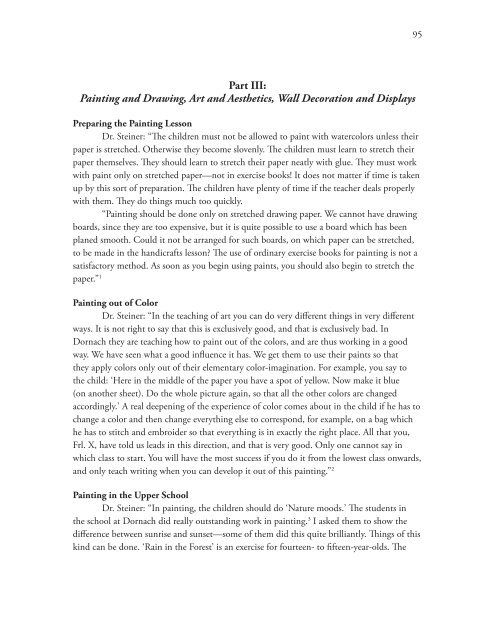Handwork and Handicrafts - Waldorf Research Institute
Handwork and Handicrafts - Waldorf Research Institute
Handwork and Handicrafts - Waldorf Research Institute
Create successful ePaper yourself
Turn your PDF publications into a flip-book with our unique Google optimized e-Paper software.
95<br />
Part III:<br />
Painting <strong>and</strong> Drawing, Art <strong>and</strong> Aesthetics, Wall Decoration <strong>and</strong> Displays<br />
Preparing the Painting Lesson<br />
Dr. Steiner: “The children must not be allowed to paint with watercolors unless their<br />
paper is stretched. Otherwise they become slovenly. The children must learn to stretch their<br />
paper themselves. They should learn to stretch their paper neatly with glue. They must work<br />
with paint only on stretched paper—not in exercise books! It does not matter if time is taken<br />
up by this sort of preparation. The children have plenty of time if the teacher deals properly<br />
with them. They do things much too quickly.<br />
“Painting should be done only on stretched drawing paper. We cannot have drawing<br />
boards, since they are too expensive, but it is quite possible to use a board which has been<br />
planed smooth. Could it not be arranged for such boards, on which paper can be stretched,<br />
to be made in the h<strong>and</strong>icrafts lesson? The use of ordinary exercise books for painting is not a<br />
satisfactory method. As soon as you begin using paints, you should also begin to stretch the<br />
paper.” 1<br />
Painting out of Color<br />
Dr. Steiner: “In the teaching of art you can do very different things in very different<br />
ways. It is not right to say that this is exclusively good, <strong>and</strong> that is exclusively bad. In<br />
Dornach they are teaching how to paint out of the colors, <strong>and</strong> are thus working in a good<br />
way. We have seen what a good influence it has. We get them to use their paints so that<br />
they apply colors only out of their elementary color-imagination. For example, you say to<br />
the child: ‘Here in the middle of the paper you have a spot of yellow. Now make it blue<br />
(on another sheet). Do the whole picture again, so that all the other colors are changed<br />
accordingly.’ A real deepening of the experience of color comes about in the child if he has to<br />
change a color <strong>and</strong> then change everything else to correspond, for example, on a bag which<br />
he has to stitch <strong>and</strong> embroider so that everything is in exactly the right place. All that you,<br />
Frl. X, have told us leads in this direction, <strong>and</strong> that is very good. Only one cannot say in<br />
which class to start. You will have the most success if you do it from the lowest class onwards,<br />
<strong>and</strong> only teach writing when you can develop it out of this painting.” 2<br />
Painting in the Upper School<br />
Dr. Steiner: “In painting, the children should do ‘Nature moods.’ The students in<br />
the school at Dornach did really outst<strong>and</strong>ing work in painting. 3 I asked them to show the<br />
difference between sunrise <strong>and</strong> sunset—some of them did this quite brilliantly. Things of this<br />
kind can be done. ‘Rain in the Forest’ is an exercise for fourteen- to fifteen-year-olds. The

















